Awara is a healthy, popular Northern Nigerian dish made from soya beans, it is also common in western Nigeria. It is called Tofu in English and Awara, Wara or Beske in Nigeria, although beske is fried tofu. Fresh Awara is soft and almost white in colour. It is high in protein and iron but low in fat and also has a low-calorie count.
Well-made Awara has a slightly discernible clean beany flavour. The flavour is not pronounced which makes it suitable for both sweet and savoury dishes. It is highly absorbent and takes on the flavour of the ingredients used in cooking it. Awara is so easy to make, my first attempt turned out so good. I immediately seasoned and fried up some, Son no.3 said it tastes like chicken.
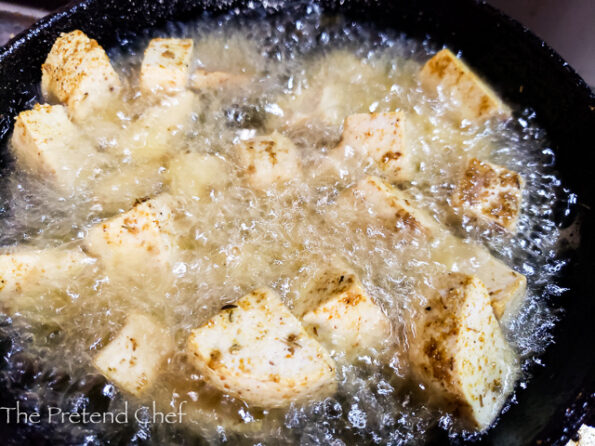
Awara (Tofu) is a vegetarian/vegan’s delight, it is an excellent meat substitute and perfect for those who want to reduce their meat intake. Awara can be added to soups, sauces and stews, it can also be eaten as a snack. There are so many ways to cook and eat it, I will put up a few recipes.
In making Awara, soybean is soaked in water for some hours, during this soaking period, the beans swell up to 2-3 times their former size. Make sure you use a bowl that will contain this increase in volume.
Storage
Awara can be placed in a bowl of salted water and then stored in the refrigerator for 4-7 days. If your Awara starts tasting sour and the liquid used in storing it becomes cloudy, it is a sign that it’s getting spoilt, throw it out. Place Awara in freezer bags or airtight containers and store in the freezer for up to 3 months.
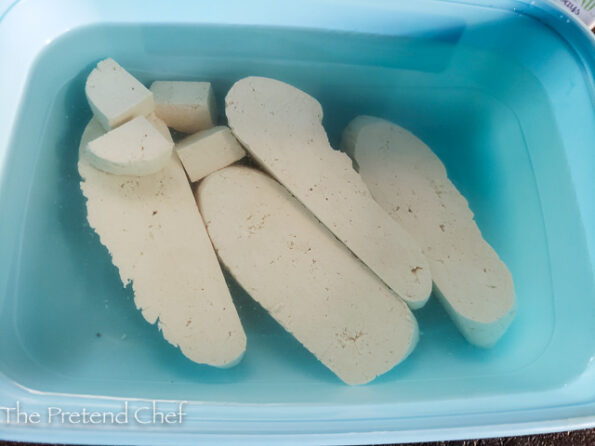
Coagulation
In order to separate the Awara (beans curd) from the whey (liquid), you need a coagulant. This coagulant when added to the soy milk will make the milk protein curdle. There are different coagulants that can be used to make Awara:
- Tamarind juice (Tsamiya)
- Alum
- Lemon juice
- Dan Tsaami (Citric lemon)
- Omi ogi (Fermented water from raw corn pap)
- Epsom salt (Magnesium Sulphate)
- Fermented whey (liquid) of Awara (tofu)
- White Vinegar
- Apple cider vinegar
- Nigari (Natural magnesium chloride)
- Gypsum (Calcium sulphate)
- Gluconolactone (GDL, it’s an acid)
- Extract from white Zobo (Sorrel)
Firmness
Awara can range from soft to firm, the firmness all depends on:
- Coagulant used
- Length of time the water was left to drain
Soft Awara is good for soups, stews and sauces while the firm is better for salads, stirfry and snacking.
To prevent Soyabean milk from boiling over
Soya milk normally foams and boils over when cooking, here are ways to reduce foaming:
- Stir the boiling soybean milk while it’s boiling
- Slide off the heat briefly
- Reduce the heat from high to low
- Add a few teaspoons of Palmoil to the ground soybeans before sieving it
- Sprinkle water on the boiling, foaming milk
To make Awara (Soyabean Tofu, Beske, Wara)
Soya beans Lemon juice (or other coagulant see above) Water
Equipment for making Awara
large bowls Chiffon cloth (Cheese cloth) Pot Stirring spoon Scooping spoon Sieve Mold (optional) Weight Chopping board or tray Knife Storage container
Pick through soya beans to remove any grit and dirt. Wash several times in clean water to remove sand.
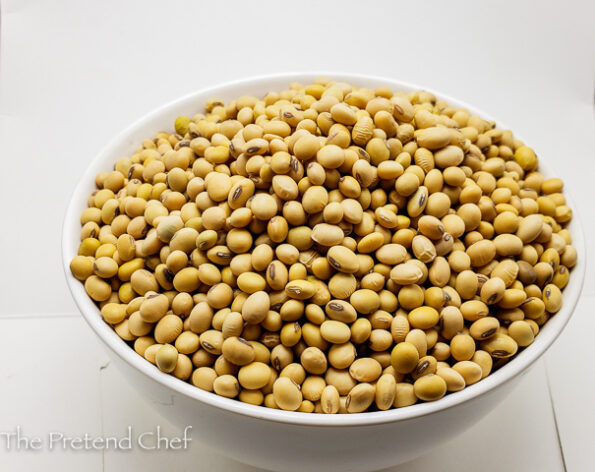
Place in a large bowl and add cover with water. It will eventually double in size so make sure there’s enough water to keep the beans under water.
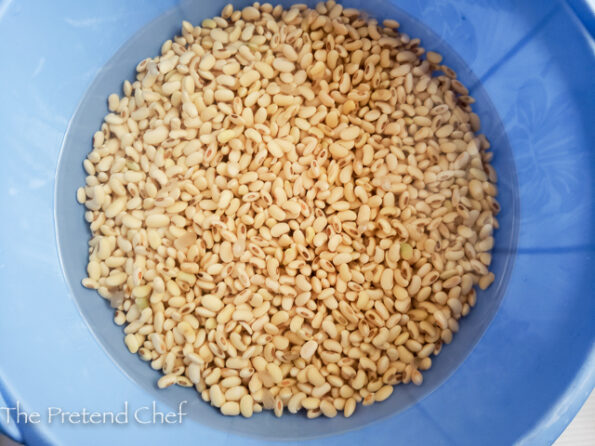
Leave to soak for at least 3 hours to overnight.
Strain, rinse a few times. Remove any bad soya beans (red or black).
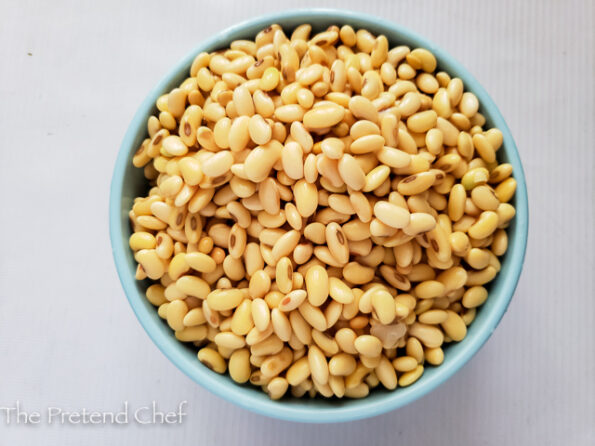
Using a blender puree the beans as finely as you can.
Pour into a large bowl and add some water to the beans paste, stir very well.
Dissolve your coagulant of choice in about 1 cup of water, and set aside.
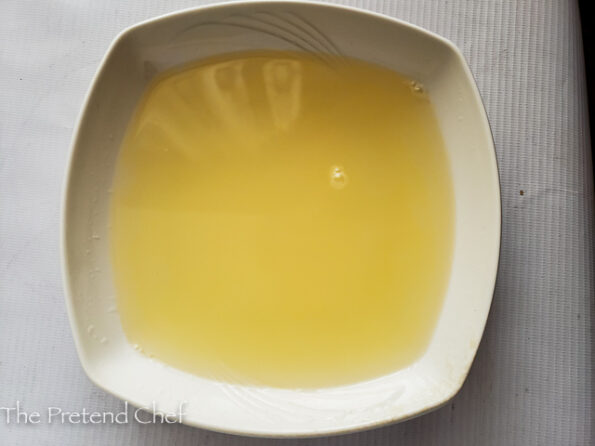
Place a sieve lined with chiffon cloth over a pot, pour in the soya bean milk and strain, squeezing out as much milk as possible from the cloth. You can add more water to the bean chaff and sieve again.
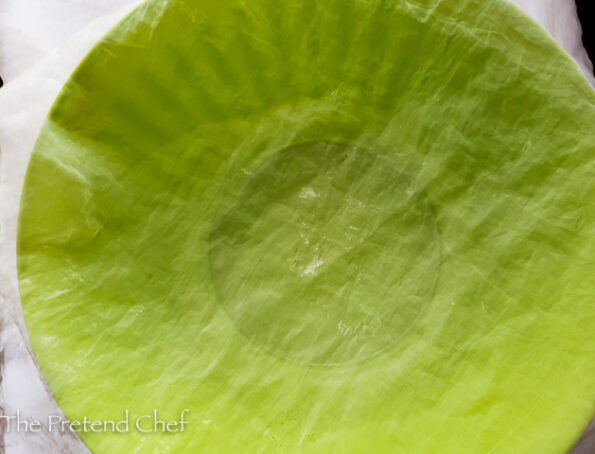
Place the milk in a large pot (the milk will rise and foam) over high heat, and cook until you see steam and bubbles. Stir constantly to avoid burning.
Cook for 5-10 minutes to remove the raw soy taste (at this point it is ready to strain and drink as soy milk).
Sprinkle or stir in your diluted lemon juice on the milk, the milk will start bubbling up.
Awara is ready when the curd separates from the whey (water) and the whey is clear and not cloudy.
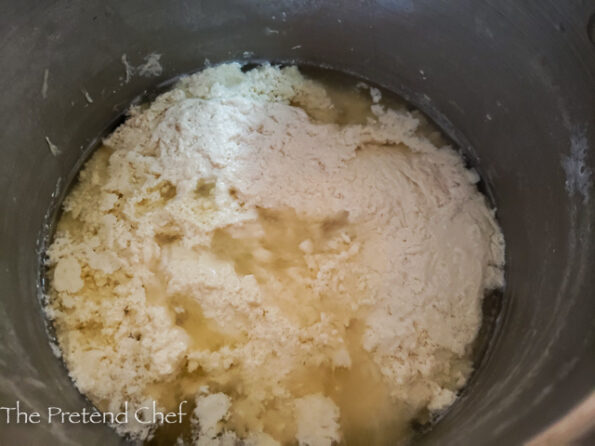
Wet your chiffon cloth, and line your mould or sieve with the cloth.
Immediately scoop the Awara into the cloth, cover or tie up tightly and place weights on top to squeeze out the water.
(At this point, you can add finely chopped pepper, onions and seasoning cube before squeezing)
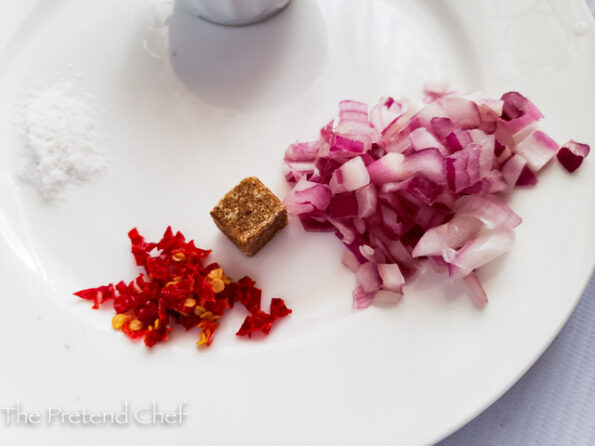
Leave for at least 20 minutes (the longer you leave it, the firmer and stronger the Awara).
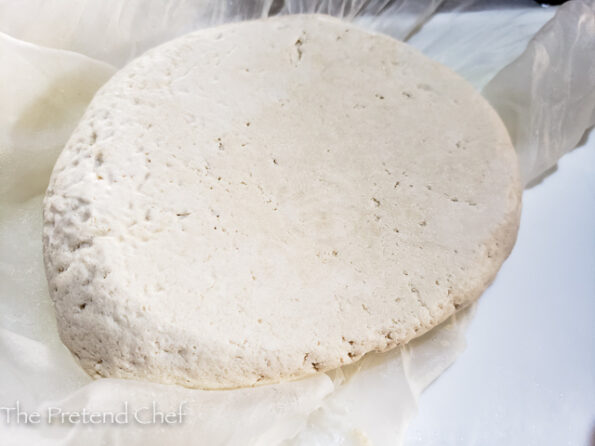
Slice Awara and place in a bowl of salted water. This will remove the taste of lemon, vinegar or other acids.
Your Awara is ready.
- Fry in hot oil for a delicious snack (Beske), and serve with pepper sauce.
- Serve fried Awara with shredded cabbage and yaji (Suya seasoning).
Notes
- If there are bubbles in the soaking water, it’s likely you have oversoaked it. Rinse out immediately and grind.
- If soaking overnight, change the water before going to bed.
- If you are grinding with your household blender, the longer you soak the beans, the softer it becomes and the easier it is for the blender to grind it well.
- You can take boiling soymilk off the heat and let sit for 15 to 20 minutes. The temperature will drop to 70 to 80 deg. C (158-176 deg. F). This step is important, as the coagulation of the soybean proteins into curds (Awara) depends on temperature. If the soymilk is too hot, the curds will be small in size and the Awara will crumble easily, if the soymilk is too cold, the Awara produced will be small.
- If you use too much alum, your Awara will be bitter.
If you enjoyed my Awara (Soya Bean Tofu, Wara, Beske), you will also enjoy my Easy Awara Tomato Stew (Tofu Stew, Tofu Sauce), How to make Akara (Bean cake, beans fritters, Kosai), Tigernut Energy Balls and Meat and rice-filled buns.
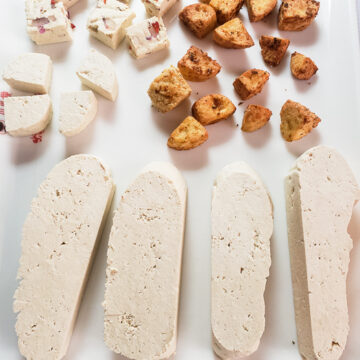
Awara (Nigerian Tofu, Wara, Beske)
Equipment
- large bowls
- Chiffon cloth (Cheese cloth)**
- Pot
- Stirring spoon
- Scooping spoon
- Sieve
- Mold (optional)
- Weight
- Chopping board or tray
- Knife
- Storage container
Ingredients
- Soya beans
- Lemon juice
- Water
Instructions
- Pick through soya beans to remove any grit and dirt. Wash several times in clean water to remove sand.
- Place in a large bowl and add cover with water. It will eventually double in size so make sure there's enough water to keep the beans under water.
- Leave to soak for at least 3 hours to overnight.
- Strain, rinse a few times. Remove any bad soya beans (red or black).
- Using a blender puree the beans as finely as you can.
- Pour into a large bowl and add some water to the beans paste, stir very well.
- Dissolve your coagulant of choice in about 1 cup of water, and set aside.
- Place a sieve lined with chiffon cloth over a pot, pour in the soya bean milk and strain, squeezing out as much milk as possible from the cloth. You can add more water to the bean chaff and sieve again.
- Place the milk in a large pot (the milk will rise and foam) over high heat, and cook until you see steam and bubbles. Stir constantly to avoid burning.
- Cook for 5-10 minutes to remove the raw soy taste (at this point it is ready to strain and drink as soy milk).
- Sprinkle or stir in your diluted lemon juice on the milk, the milk will start bubbling up.
- Awara is ready when the curd separates from the whey (water) and the whey is clear and not cloudy.
- Wet your chiffon cloth, and line your mold or sieve with the cloth.
- Scoop the Awara into the cloth, cover or tie up tightly and place weights on top to squeeze out the water.
- Leave for at least 20 minutes (the longer you leave it, the firmer and stronger the Awara).
- Slice Awara and place in a bowl of salted water. This will remove the taste of lemon, vinegar or other acids.
- Your Awara is ready.
Notes
- If there are bubbles in the soaking water, it's likely you have oversoaked it. Rinse out immediately and grind.
- If soaking overnight, change the water before going to bed.
- If you are grinding with your household blender, the longer you soak the beans, the softer it becomes and the easier it is for the blender to grind it well.
- You can take boiling soymilk off the heat and let sit for 15 to 20 minutes. The temperature will drop to 70 to 80 deg. C (158-176 deg. F). This step is important, as the coagulation of the soybean proteins into curds (Awara) depends on temperature. If the soymilk is too hot, the curds will be small in size and the Awara will crumble easily, if the soymilk is too cold, the Awara produced will be small.
Do you have any comments, questions or suggestions, please leave a comment below.
Subscribe to the blog for instant notifications of new recipes, leave your email address in the box above.
Please share this recipe using the share buttons.
Follow on Instagram: @thepretendchefofficial, Twitter: @thepretendchef Facebook: https://web.facebook.com/thepretendchef/, Pinterest: https://www.pinterest.com/thepretendchef/
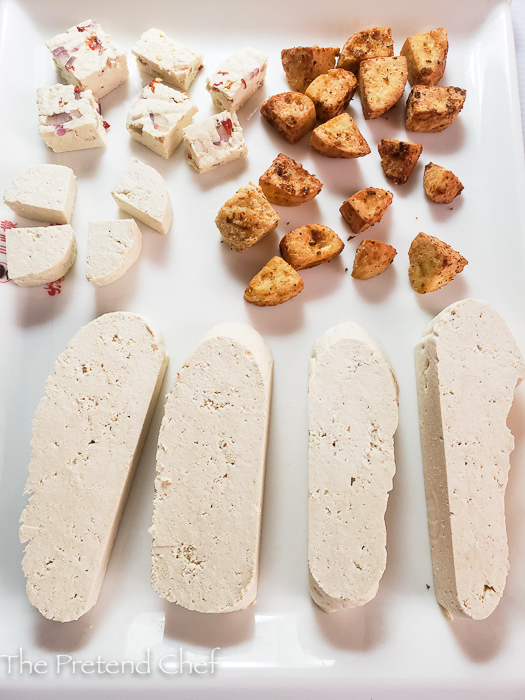
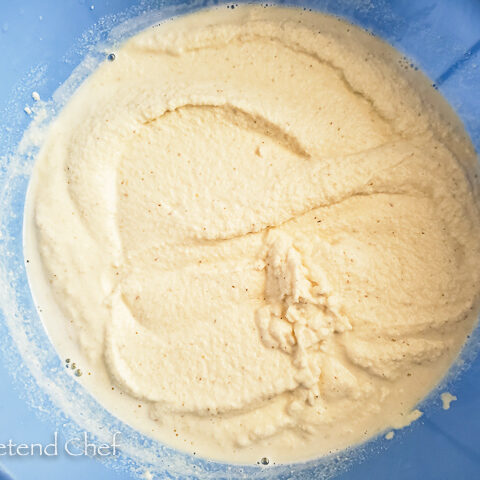
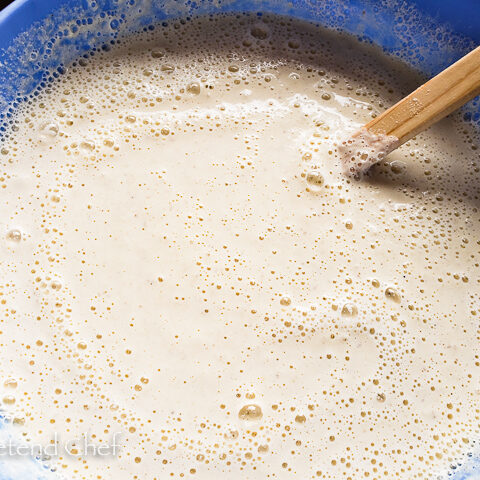
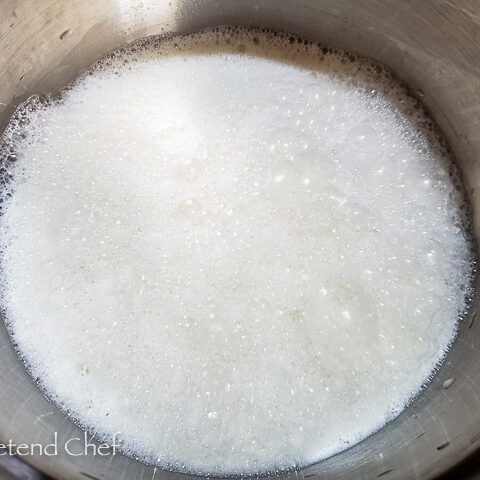
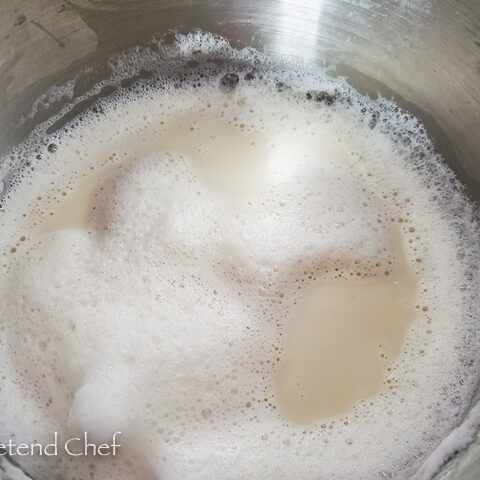
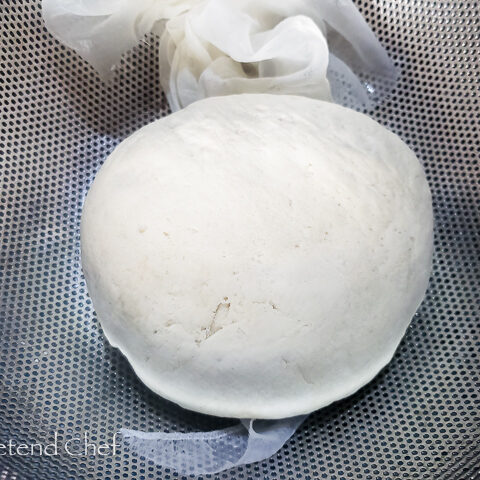
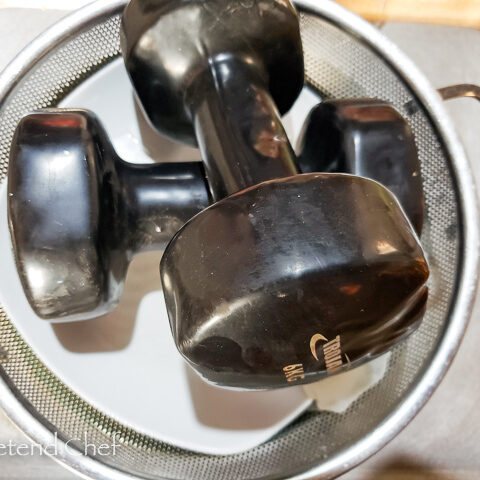
 I am Ganiru, a wife, a mother, a food blogger, a chef, an author and an accountant. I love to cook and write about food, especially Nigerian and afro-centric food...
I am Ganiru, a wife, a mother, a food blogger, a chef, an author and an accountant. I love to cook and write about food, especially Nigerian and afro-centric food...
love it
Love this
Pingback: Awara cabbage salad (Tofu Cabbage Salad) - The Pretend Chef